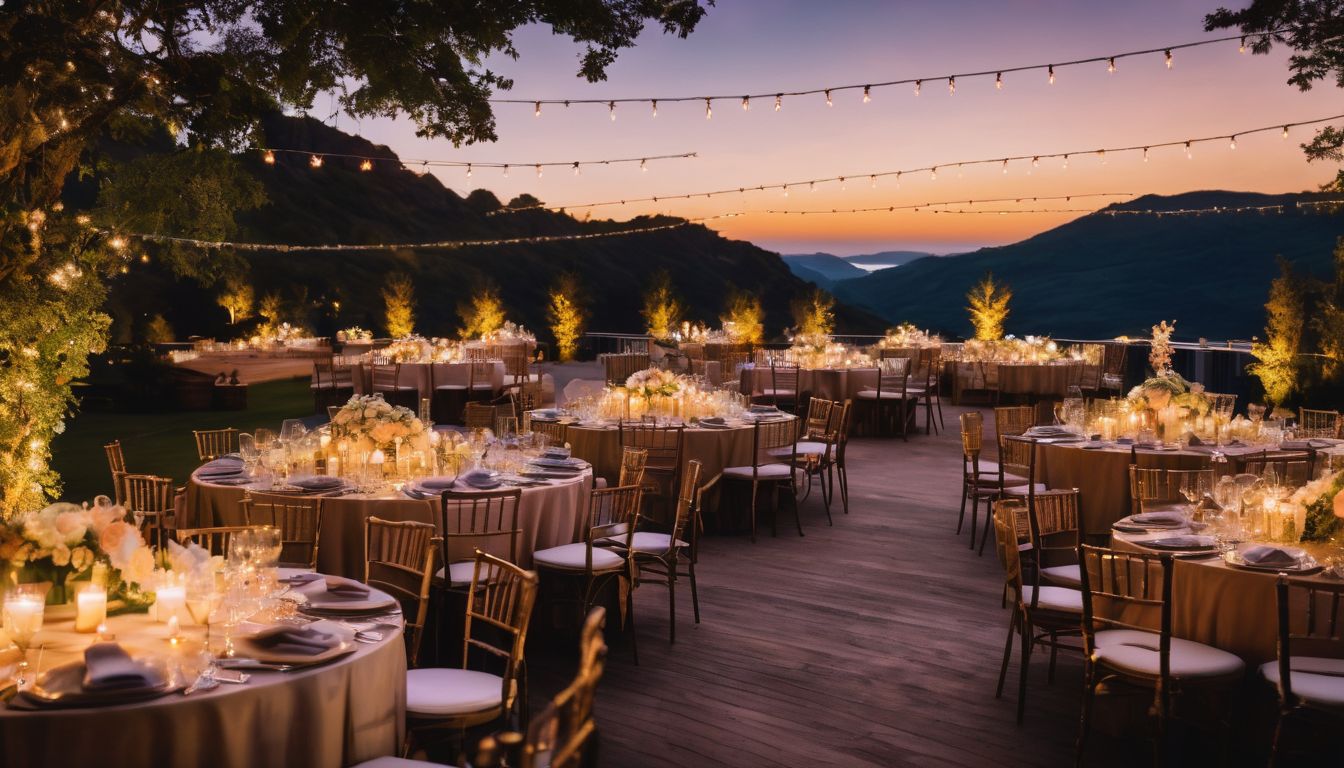Choosing the perfect frame rate for a wedding video can seem confusing with all the technical options available. It’s widely known that capturing those once-in-a-lifetime moments calls for a balance of cinematic quality and smooth motion, often fulfilled by shooting at 60fps.
This article will guide you through selecting the ideal frame rate to ensure your wedding footage looks both stunning and heartfelt. Ready to make every second count? Let’s dive in!
Key Takeaways
- Most movies use 24 frames per second, giving a smooth and dreamy look that’s great for weddings.
- High frame rates like 120 or 240 fps are perfect for slow-motion shots of special moments.
- It’s important to choose the right frame rate because it affects how smooth your video looks and feels.
- Filming b-roll at 4k, 60fps provides high-quality extra footage and helps in making slow-motion clips look better.
- The cost of a wedding videographer can be between £1,500 to £2,500. Couples often spend about 5 – 9% of their total wedding budget on videos.
Understanding Frame Rates

Frame rates determine the number of frames or images that are displayed per second in a video. This affects how motion is captured and displayed, making it an essential consideration for wedding videography.
Definition and importance of frame rate
Frame rate tells us how many pictures a video camera takes in one second. It’s like a flipbook; the quicker you flip through the pages, or frames, the smoother the picture looks. Filmmakers use frame rates measured in fps to make sure their movies look real and tell their story well.
A good frame rate is key for making videos that people enjoy watching. For wedding videography, choosing this rate carefully can mean the difference between a film that feels magical and one that just doesn’t work.
High-quality videos need the right balance of motion and stillness, which all comes down to frame rate.
Common Frame Rates Used in Videography

“Common frame rates used in videography include 24 frames per second (24p), 30 frames per second (30p), and high frame rates (HFR) like 120 or 240 fps, each offering unique features that cater to different creative needs and preferences.
Click here to learn more about the best frame rate for wedding videos.”.
24 frames per second (24p)
Frames zip by at 24 every second in a video shot at 24p. This speed makes films look smooth and gives them that dreamy, movie-like quality we all know. Think of it like flipping through a book really fast—it’s the same idea with pictures flashing before your eyes to create motion.
The choice for filming weddings this way comes from the big screen—long ago they found out 24 frames per second was just right for making sound work well and keeping things looking magical.
Choosing to shoot a wedding at 24p means those special moments—the first kiss, the dance moves, and laughter—all feel like part of a story you’d see in the cinema. It wraps up the day beautifully because everything seems more graceful and full of emotion.
Remember how old-time films tug at our hearts? That’s exactly what you get with each glance and giggle caught on camera: pure cinematic charm!
30 frames per second (30p)
Thirty frames per second is a popular choice for recording wedding videos. It combines clarity and smoothness in movement, making it great for capturing all the special moments. TV shows and online videos often use this frame rate because it looks clear on many screens.
Each passing second has thirty full pictures, which helps everything move without looking choppy or strange.
Choosing 30p can also be smart for file size. Since each image only needs to send once even though it flashes twice, you save bandwidth. For weddings, this frame rate works well because it gives life-like motion that looks good when played back.
Videographers aim for that natural feel so viewers feel like they’re right there at the wedding.
High frame rates (HFR) like 120 or 240 fps
High frame rates swing into action when you want to catch every tiny move. Let’s say the bride throws her bouquet or tears of joy roll down a cheek; shooting at 120 or 240 fps can slow these moments way down.
This makes everything look smooth and dramatic. The magic is in the details, which high frame rates capture perfectly.
Videographers often use these fast speeds for short, special parts of the wedding video. They turn quick actions into long, beautiful scenes that you can watch over and over. With HFR, those heartfelt moments transform into stunning slow-motion memories that last a lifetime.
Frame Rate for Wedding Videography
When capturing a wedding video, selecting the right frame rate is crucial to achieving the desired cinematic effect. While 24 frames per second (24p) is often preferred for its classic and film-like quality, high frame rates (HFR) can also add depth and drama to slow-motion sequences during key moments of the event.
Importance of selecting the right frame rate
Picking the correct frame rate is key to making sure your wedding video looks amazing. It helps you capture movements smoothly and show real-life emotions. Think of the frame rate like the heartbeat of your video – it brings everything to life.
If you choose a high frame rate, you get to add dreamy slow-motion shots that can highlight special moments, like when the bride tosses her bouquet or during a romantic dance.
Yet going for higher frame rates isn’t always best because they can push up the cost later in editing. This means more time and money spent in post-production. So, it’s smart to balance between getting those beautiful slow-mo effects and sticking to a budget.
The right choice lets your wedding film tell the story without any shaky scenes or blurs – just pure emotion-filled memories captured perfectly forever.
Preference for 24p for a cinematic feel
Many wedding videos are shot at 24 frames per second. This choice gives the film a look that feels like a movie we might see in a cinema. It’s because this frame rate is what most movies use.
People love 24p for weddings as it adds a touch of magic and looks professional.
Choosing 24p can give the big day’s footage that special glow. It makes romantic moments even more beautiful to watch later on. Shooting at this speed helps to capture emotions in a way that looks smooth, just like in the films everyone loves.
Use of high frame rates for slow-motion sequences
High frame rates make slow-motion in wedding videos look magical. Capturing more frames per second lets you slow down moments to see every smile and tear drop.
- Slow motion captures the emotions of a wedding in a way that regular video can’t. When you film at high frame rates like 120 or 240 fps, you get many pictures each second.
- To show these pictures slowly on screen, you play them back at a normal speed. This makes everything move in slow motion.
- Shooting at high frame rates is perfect for special parts of the day. You might use it for the first dance or when confetti is thrown.
- You need good light for high frame rate filming. More frames mean each picture is captured quickly, so less light gets in.
- Videographers often use powerful cameras with settings that work well with lots of movement. Cameras like Canon EOS or Panasonic Lumix are great choices.
- It’s also important to set your camera right when filming slow motion. A rule is to double your shutter speed compared to the number of frames per second you’re shooting.
- Using the right lenses matters too. A wide – angle lens can capture more and help avoid camera shake, which looks worse in slow motion.
- Remember to plan your shots ahead of time. Know what moments you want in slow motion before the big day starts.
Filming Guidelines for Wedding Videography
When capturing footage for a wedding video, it’s crucial to pay attention to camera settings and preparation. B-Roll should be captured at 4k, 60fps to ensure high-quality supplementary footage.
Camera settings and preparation
When preparing for wedding videography, proper camera settings are crucial. Ensure the frame rate matches the recording speed or disable it to avoid issues. Familiarise yourself with framing and composition techniques to capture quality footage.
Pay attention to detail at every stage of production, from preparation to filming and editing, using appropriate settings for a successful outcome.
It’s important that camera settings match the required frame rate; otherwise, disabling it is necessary. Be mindful of composition techniques while capturing the event through your lens..
B-Roll capture at 4k, 60fps
When capturing b-roll for wedding videography, it’s essential to prioritise the quality of the footage. Filming at 4k, 60fps ensures that the additional footage is crisp and smooth, offering flexibility during editing and producing high-quality slow-motion sequences where needed.
It’s crucial to check if your primary camera supports these settings; upgrading may be necessary to meet this standard.
Remember that b-roll footage often complements the narrative of the main event, making it a vital component in crafting a compelling wedding video. The versatility offered by 60fps provides ample room for creativity both during filming and post-production, ultimately enhancing the overall visual appeal of your wedding videography work.
Cost Considerations for Wedding Videography
1. The average cost for a professional wedding videographer ranges from $1,500 to $2,500.
2. In 2020, couples allocated around 16.7% of their wedding budget to photo and video services.
3. It is recommended to allocate approximately 5-9% of the overall wedding budget specifically for a wedding filmmaker.
4. Costs may also vary based on factors such as the duration of coverage required and any additional services or special requests.
Conclusion
In conclusion, the frame rate for wedding videos plays a crucial role in capturing the memorable moments of the special day. Understanding the impact of different frame rates allows videographers to create visually stunning and emotionally captivating wedding films.
By selecting suitable frame rates, such as 24p for cinematic elegance or higher frame rates for enchanting slow-motion sequences, videographers can enhance the storytelling aspect of wedding videos and deliver an exceptional visual experience that resonates with couples and their loved ones.
It is clear that mastering frame rates empowers videographers to craft timeless wedding films that preserve cherished memories with artistry and finesse.
For a detailed breakdown of the potential costs associated with wedding video editing, visit our guide on wedding videography pricing.
FAQs
1. What’s the best frame rate to use for a wedding video?
For a smooth look that captures the romantic atmosphere of the day, shooting your wedding video at 24 or 25 frames per second is ideal—that’s what they use in films! It gives you that cinematic motion blur and keeps everything looking dreamy.
2. Can I shoot my wedding video in high definition with this frame rate?
Absolutely, yes! Whether it’s Full HD or even 4K, using a frame rate of 24 or 25 fps will still give you crisp, high-definition footage. Your memories will look sharp and clear.
3. Should I adjust my camera settings if it’s too bright outside during the ceremony?
Indeed—when faced with bright sunlight, an ND filter can be your best friend! Slapping one onto your lens helps control exposure without changing other settings like ISO range or shutter speeds much. So no more squinting faces!
4. Will different cameras affect how my wedding video looks?
Different cameras do have their quirks—for instance, mirrorless cameras offer in-body image stabilisation which is great for handheld shots—and tech like DIGIC X and BIONZ processors ensure top-notch image quality from brands like Canon and Sony respectively.
5. How can I make sure everyone hears our vows clearly on the video?
No need to worry about sound—the shotgun mic setup assures every word is caught clearly when you’re saying “I do.” And if you’ve got wireless microphones handy, those are perfect for crystal clear audio without any messy wires getting in the way.
6. Is there anything else I should know about capturing movement at weddings?
Of course—if folks are dancing up a storm at the reception? You might want to bump up that frame rate just a bit higher than usual—to something around 60 fps perhaps? That way, all those quick moves won’t turn into blurs on screen.






